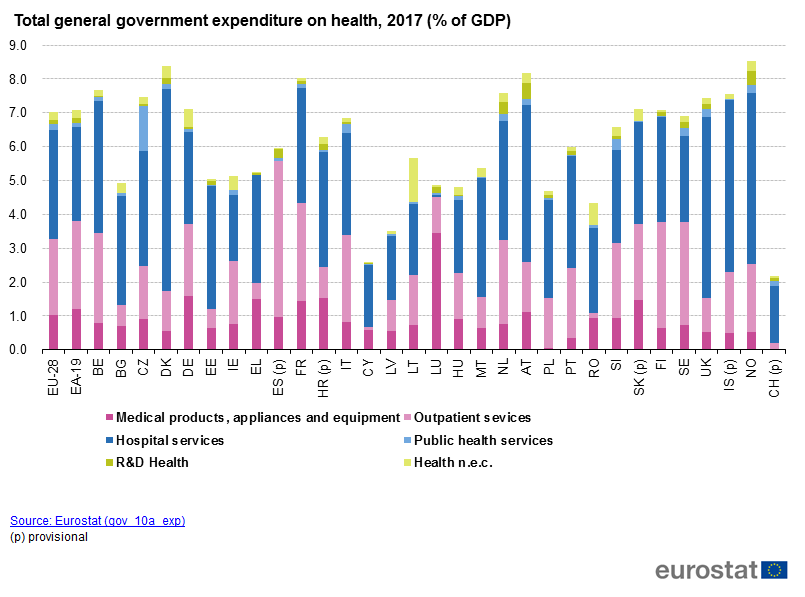Poles spend almost 10 billion zloty per year on private healthcare, according to a report by INFARMA, an association of pharmaceutical companies. At the same time, public spending on healthcare in Poland is among the lowest in the European Union.
The poor state of Poland’s healthcare system results in 20,000 deaths annually from preventable diseases, and the country’s life expectancy is actually declining, warns INFARMA.
The report acknowledges that in recent years the Polish government has been increasing public spending on healthcare. But it finds that the rate is too slow to catch up with the standards of other European countries, noting that it will be “very difficult to improve healthcare results” given the current budget.
According to Eurostat, in 2017 EU governments together spent the equivalent of 7% of their GDP on healthcare. The figure for Poland was just 4.7%, with only four other member states spending less.

Poland’s spending is behind not only Western Europe, but also other countries in its region. The Czech Republic and Slovakia both devoted over 7% of their GDP to healthcare in 2017, for example.
Poland spends an average of 500 zloty per resident on medicine, whereas the average for Central and Eastern European countries is 1,050 zloty, notes the INFARMA report.
According to 2018 research by The King’s Fund, an independent UK-based think-tank specialising in healthcare, Poland has the lowest number of doctors and nurses per 1000 inhabitants out of the 21 countries studied, including the Czech Republic and Slovakia.
Poland has the lowest number of doctors and nurses in proportion to population, as well as the lowest healthcare spending as a share of GDP, notes new report by @TheKingsFund (https://t.co/RvwKbxFBc6) pic.twitter.com/YhgE55WloS
— Notes from Poland ?? (@notesfrompoland) May 6, 2018
One consequences of these deficiencies is that 20,000 Poles die prematurely every year from preventable diseases, a figure one third higher than the EU average. Poles also live on average three years less than the EU norm, and life expectancy in Poland has actually started to decline, warns INFARMA.
Low investment in healthcare prompted strikes in 2017 by resident doctors, who demanded an increase in public spending on healthcare as well as rises in their salaries, which were amongst the lowest in Europe: between 3,170 zloty (€737) and 3,890 zloty (€904) a month.
In February 2018, the protesting doctors reached an agreement with the government, which promised to gradually boost healthcare spending to 6% of GDP by 2024 and to increase resident doctors’ salaries to between 4,000 zloty and 5,300 zloty.
Doctors from outside the EU may soon be given an easier path to work in Poland, under government plans to tackle staff shortages in the health service.
After a year's training and passing an exam in Polish, they will be entitled to work for up to 5 years https://t.co/MIy3jUrJAD
— Notes from Poland ?? (@notesfrompoland) September 4, 2019
The strike organisers have, however, subsequently accused the government of breaking the agreement, in particular by still not devoting enough public money to the health sector. At the beginning of this month, doctors sat down with government again to re-open the negotiations.
According to the INFARMA report and to OECD data, in 2018 Poland’s public expenditure on health stood at 4.5% of GDP. In absolute numbers, this means that the government would need to add 33 billion zloty to reach the 6% target, three times more than Poles spend yearly on private healthcare.
Ahead of October’s parliamentary elections, PiS presented a five-point plan to improve healthcare in its next term. This included ensuring everyone has access to free health check-ups and spending a billion zloty on creating the most modern oncology centre in Europe.

Monika Prończuk is the deputy editor of Notes from Poland. She was previously the Nico Colchester fellow at the Financial Times, acting FT Poland correspondent, and journalist at OKO.press, an independent fact-checking media outlet. Her articles have appeared in Quartz, Financial Times, Politico, Gazeta Wyborcza and Tygodnik Powszechny.




















